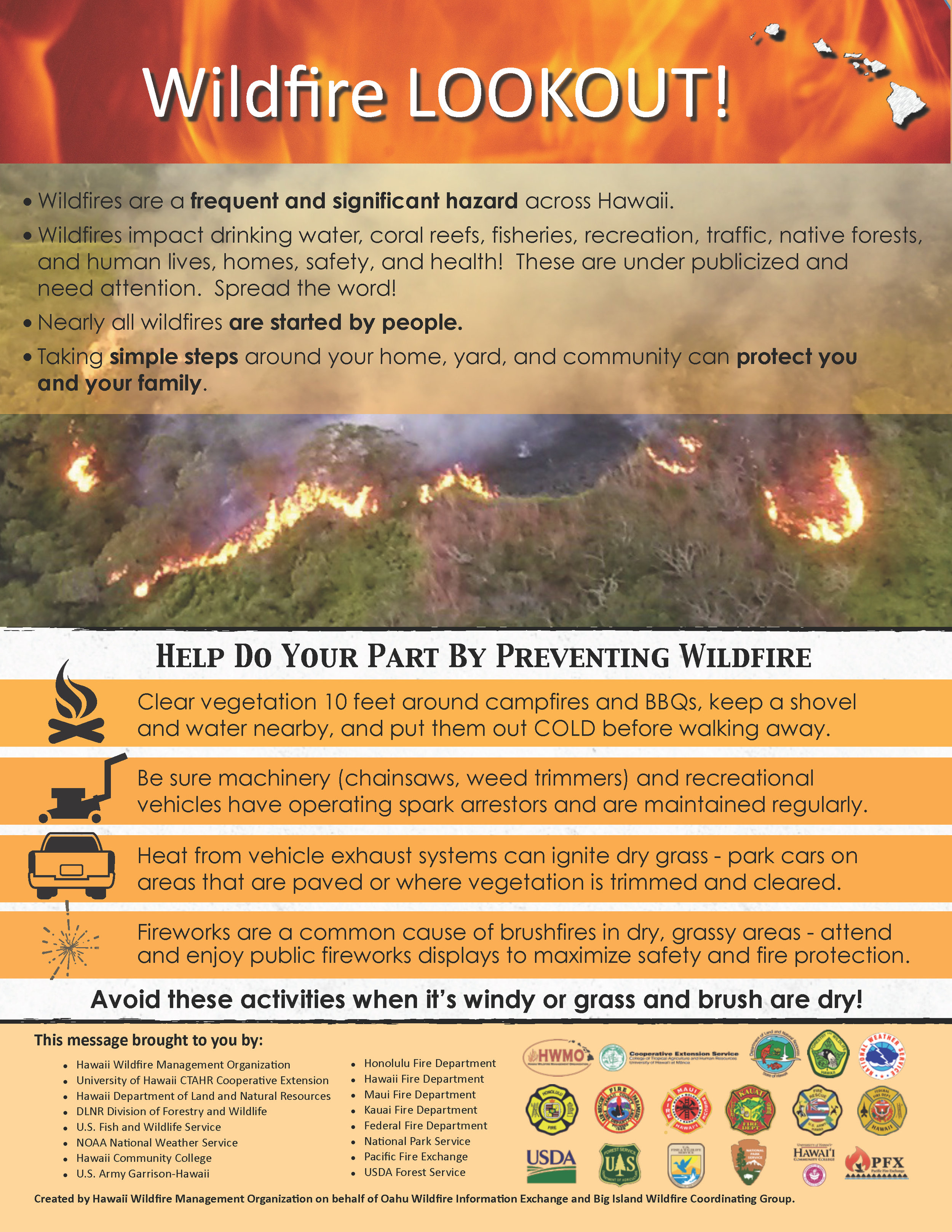2017 Wildfire in Hawaii - PFX Annual Summary
Check out this brand new resource to learn how the wildfire season went in Hawaii in 2017 with this Pacific Fire Exchange fact sheet. Download the full fact sheet by clicking the button below.
"Every wildfire incident is part of a larger pattern of wildfire occurrence and is an opportunity to gain experience and insight for wildfire management. Taking a look at both the big picture and individual fires can: Deepen and expand our understanding of wildfire drivers, behavior, and response; improve wildfire response, management, and science; reduce negative impacts on individuals, communities, natural resources, and response agency budgets."
Wildfire in Hawaii Factsheet
Did you know that the average area burned per year in Hawaii has increased 400% over the past century? Check out this Pacific Fire Exchange fact sheet that presents Hawaii Wildfire Management Organization's State Wildfire History Map and Dr. Clay Trauernichts' key findings from his research on the scale and scope of wildfire in Hawaii.
"Over the past decade, an average of >1000 wildfires burned >17,000 acres each year in Hawai‘i, with the percentage of total land area burned comparable to and often exceeding figures for the fire-prone western US (Fig. 1). Humans have caused much of the increase in wildfire threat by increasing the abundance of ignitions (Fig. 2) and introducing nonnative, fire-prone grasses and shrubs. Nonnative grasslands and shrublands now cover nearly one quarter of Hawaii's total land area and, together with a warming, drying climate and year round fire season, greatly increase the incidence of larger fires (Fig. 3), especially in leeward areas. Wildfires were once limited in Hawai‘i to active volcanic eruptions and infrequent dry lightning strikes. However, the dramatic increase in wildfire prevalence poses serious threats to human safety, infrastructure, agricultural production, cultural resources, native ecosystems, watershed functioning, and nearshore coastal resources statewide."
Hawaii Wildfire Impacts Flyer
Emergency Management Careers Infographic
Click the infographic above to enlarge.
"Emergency management professionals provide the framework for our society's survival after disasters occur. Given how consistently disasters occur and the need to limit the damage from emergencies and disasters, there is now, more than ever, a need for emergency management professionals. In fact, the field is expected to steadily grow well into 2024.
The above infographic, created by Arizona State University's Online Emergency Management and Homeland Security (EMHS) degree program, explores the field of emergency management and the various professions one might pursue."
- Shared by Pearson Online Learning Services
Wildfire Virtual Field Trips
Screen capture from NFPA video.
Check out this video series put together by the NFPA and experience what happens one year, five years, and ten years after a major wildfire. The lessons learned from these videos focus largely on how you can take measures around your home and yard to reduce wildfire risks. One of the videos focuses on the ecological importance of wildfires on the mainland. It's important to keep in mind that in Hawaii and the Western Pacific, wildfires are NOT a part of the natural process and actually harm our native forests, watersheds, and coastlines.
Disaster Safety & Assistive Technology: Protection for Seniors & the Disabled
Here is a resource with excellent information on how to better prepare our kupuna and the disabled for emergencies.
From the Source:
"When disaster strikes, our first instinct is to check in with our loved ones and make sure they’re okay. But if your loved one is a senior or has a disability, you can’t afford to wait to “check in” — timing is everything during an emergency, and you need to buy them as much time as possible to react independently. You should create an emergency preparedness guide to keep them safe and accessible even as a crisis is unfolding.
Wildfire Research Fact Sheet: Decks
Firewise's new wildfire research fact sheet has some great information on how to reduce the ignitability of your deck or lanai. It's just one page but packed with useful information.
From the Source:
"MANY HOMES LOCATED IN WILDFIRE-PRONE AREAS HAVE ATTACHED DECKS, WHICH CAN POTENTIALLY SPREAD FIRE TO THE HOUSE WHEN IGNITED DURING A WILDFIRE. A burning deck can ignite siding or break the glass in doors or windows, allowing fi re to gain entry into the house. Consequently, making decks less vulnerable to wildfire also makes your house less vulnerable. Reducing the deck’s vulnerability requires an approach that focuses on the materials and design features used to build the deck, and creating a noncombustible zone around and under the deck."
How to Complete New Online Firewise Application Process
Calling all Firewise Communities and potential new ones: Firewise has a new online application system worthy of checking out right away. Get started on your application early so you can see the new changes and save your progress along the way before the November 15 due date for renewals.
Wanting to get a new community started? Give us a shout and we'll help you out!
Packing and Storing Items to Prevent Damage
"Regardless of the disaster you're most at risk for, you need to know what to do to protect yourself before one strikes. A storage unit and proper storage techniques can be one of your lines of defense. This guide will look at how you can use a storage unit to protect your items as you make sure you're as prepared as possible for a potential disaster."
Thank you to Cyrus Dylan and his peer group on community safety for sharing this unique and informative resource.










